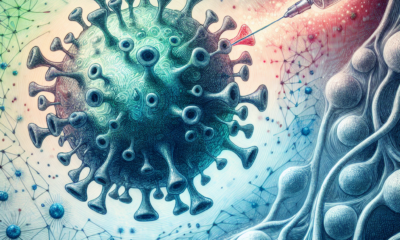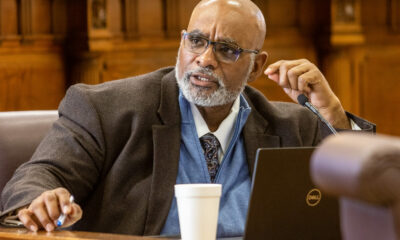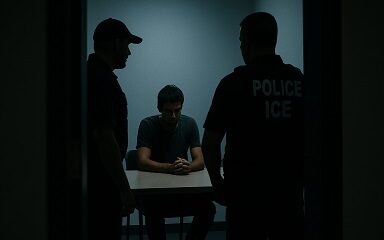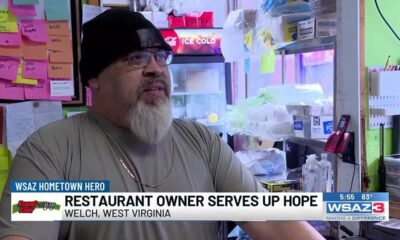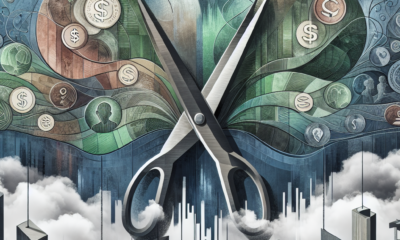Kaiser Health News
Epidemic: The Tata Way
Tue, 26 Sep 2023 09:00:00 +0000
In spring 1974, over a dozen smallpox outbreaks sprang up throughout the Indian state of Madhya Pradesh. Determined to find the source of the cases, American smallpox eradication worker Larry Brilliant and a local partner, Zaffar Hussain, launched an investigation.
The answer: Each outbreak could be traced back to Tatanagar, a city run by one of India’s largest corporations, the Tata Group.
When Brilliant arrived at the Tatanagar Railway Station, he was horrified by what he saw: people with active cases of smallpox purchasing train tickets. The virus was spreading out of control.
Brilliant knew that to stop the outbreak at its source, he would need the support of the company that ran the city. But he wasn’t optimistic the Tata Group would help.
Still, he had to try. So, Brilliant tracked down a Tata executive and knocked on his door in the middle of the night.
Brilliant’s message: “Your company is sending death all over the world. You’re the greatest exporter of smallpox in history.”
Much to his surprise, the leaders of Tata listened.
Episode 5 of “Eradicating Smallpox” explores the unique partnership between the Tata Group and the campaign to end the virus. This collaboration between the private and public sector, domestic and international, proved vital in the fight to eliminate smallpox.
To conclude the episode, host Céline Gounder speaks with NBA commissioner Adam Silver and virologist David Ho about the basketball league’s unique response to covid-19 — “the bubble” — and the essential role businesses can play in public health. “We need everyone involved,” Ho said, “from government, to academia, to the private sector.”
The Host:
Céline Gounder
Senior fellow & editor-at-large for public health, KFF Health News
Céline is senior fellow and editor-at-large for public health with KFF Health News. She is an infectious diseases physician and epidemiologist. She was an assistant commissioner of health in New York City. Between 1998 and 2012, she studied tuberculosis and HIV in South Africa, Lesotho, Malawi, Ethiopia, and Brazil. Gounder also served on the Biden-Harris Transition COVID-19 Advisory Board.
In Conversation With Céline Gounder:
Adam Silver
Commissioner of the NBA
David Ho
Director and CEO of the Aaron Diamond AIDS Research Center
Voices From the Episode:
Larry Brilliant
Former World Health Organization smallpox eradication worker in India
Click to open the transcript
Transcript: The Tata Way
Podcast Transcript Epidemic: “Eradicating Smallpox” Season 2, Episode 5: The Tata Way Air date: Sept. 26, 2023
Editor’s note: If you are able, we encourage you to listen to the audio of “Epidemic,” which includes emotion and emphasis not found in the transcript. This transcript, generated using transcription software, has been edited for style and clarity. Please use the transcript as a tool but check the corresponding audio before quoting the podcast.
TRANSCRIPT
Céline Gounder: To help us tell the next chapter of the smallpox eradication history, we went to someone who’s lived a lot of lives. A civil rights activist. A Deadhead. A disciple of guru Neem Karoli Baba. A tech entrepreneur. And … an epidemiologist.
Larry Brilliant: Hi, I’m Larry Brilliant. and I had the great honor of working on the WHO smallpox eradication program.
[Light music begins playing softly]
Céline Gounder: Larry was looking for his place in the world as a young man. It took him all over the United States. And beyond …
Larry Brilliant: Hoping that I would find something that was better than capitalism … that helped the poorest and most vulnerable communities.
Céline Gounder: That calling eventually led him to India — and the campaign to end smallpox.
Larry Brilliant: In those days, the world really wanted a victory in global health. So, we wanted, as a world, to eradicate smallpox.
Céline Gounder: At one point, when government reports suggested that smallpox was getting worse, not better, a young Larry still believed his team could beat the disease.
Many said that version of him from 50 years ago was perhaps brilliant — but also impatient, and a bit brash.
So, when one honcho at the World Health Organization headquarters in Geneva said he would eat a truck tire if they ever managed to get rid of smallpox, Larry and his boss, a Swiss-French epidemiologist named Nicole Grasset, took the bet.
A few years later, after the WHO declared victory over smallpox in 1980, Nicole and Larry mailed the skeptic a tire — all the way from India! — with a little note saying:
Larry Brilliant: “As agreed, here is the Land Rover tire. Please inform us — the bouquet and the texture — and should you need ketchup or mustard or any other condiments, we would be happy to add them to this.”
Céline Gounder: What happened to the tire?
Larry Brilliant: We never know. He never responded. [laughs]
[Music fades out]
Céline Gounder: Larry’s laughing now, but there were lots of dark days before that win. 1974 was a particularly tough year for the eradication program.
And Larry was about to find himself in the middle of one of the worst smallpox outbreaks anyone could remember.
To stop it, he would have to become a detective and follow the clues to the source of the surge. And once he solved that mystery, he’d need to stand up to one of the most powerful companies in India.
I’m Dr. Céline Gounder, and this is “Epidemic.”
[Epidemic theme music plays]
Céline Gounder: The year started off well. The new search-and-containment strategy was working.
It was working so well that Larry and his team were convinced they had eliminated smallpox in their area.
The reports from three statewide searches had come back. Not a single case had been found.
Soon, they’d be ready to declare the region free of smallpox.
[Suspenseful music begins playing]
Larry Brilliant: And we did one more search, and we found 15 villages that were infected with smallpox.
Céline Gounder: That last search was supposed to be a victory lap. Now, the race had started all over again.
Larry dispatched teams to find out where the cases were coming from.
Larry Brilliant: No one had any idea what it was.
Céline Gounder: Then finally … a break.
Larry Brilliant: We went into a little village, and we were able to find that the first case was a young man in his 20s, and he had gone someplace for work and came back with smallpox.
Céline Gounder: Larry asked the rest of the team if they had found anything similar.
Larry Brilliant: All of them came back “yes.”
Céline Gounder: They found a pattern — a clue. All the cases originated with a young person who had been away from home looking for work.
But where had they gone? If Larry’s team was going to stop the outbreak, they had to figure out where the workers got infected.
When the first clue surfaced, Larry was with another smallpox campaigner. A local partner, Zaffar Hussain …
Larry Brilliant: … who knew more about smallpox than I did. He knew more about smallpox than anybody.
Céline Gounder: Larry and Zaffar were running out of options. So, Zaffar tried one last thing.
Larry Brilliant: When they were preparing this boy’s body for cremation, Zaffar asked in the humblest way for permission to go through his pockets. And he did, and he found in the boy’s pockets a railway ticket from the Tatanagar Railway Station.
Céline Gounder: Tatanagar.
They had found the source of the outbreak.
[Suspenseful music fades out]
[Ambient sounds and an announcement from the Tatanagar Railway Station play]
Céline Gounder: In the summer of 2022, I followed Larry’s journey to the Tatanagar. The city — also known as Jamshedpur — is in the eastern end of India. The train station is a knot of railroad tracks. The platforms are full of vendors selling food. You have to dodge bales of cargo on the way to the train.
Tatanagar’s name comes from the family … and the company … that dominates the area: Tata.
Larry Brilliant: It was known as the “Pittsburgh of India.”
[Upbeat music begins playing]
Céline Gounder: Steel. Iron. Locomotives. Tata was a household name. It still is. The conglomerate’s dozens of businesses span heavy industry and telecommunications to aerospace.
Ever ride in a Land Rover? Tata.
A Jaguar? Tata.
Fly Air India? That’s part of the Tata Group, too.
In the ’70s, people looking for work in Tata factories took trains to Tatanagar. Thousands and thousands of people passed through the train station every day.
For many, the city was a vision of India’s future.
[Music fades out]
Larry Brilliant: So, when you thought of Tatanagar, when you thought of Tatas, in those days, you thought of wealth, power, modernity, cleanliness, all of those things.
Céline Gounder: But the scene Larry and Zaffar saw when they arrived was very different.
They found a station boiling with smallpox. Bodies wrapped in cloth were stacked like cords of wood.
[Somber music begins playing softly]
Céline Gounder: Some small enough to be children.
As the crowd swirled around Larry, an older man about to buy a train ticket caught his eye.
Larry Brilliant: He had given the couple of rupees, and he had just gotten the ticket and his hand was filled with pockmarks. And you could just imagine that that man’s about to get on a train and go back home to die in his home village. And that will be another outbreak that will be started.
Céline Gounder: Larry was overwhelmed.
Larry Brilliant: You gotta understand that the feeling of powerlessness, anger, anger at the Tatas for letting this happen, anger at … God?
[Music fades out]
Larry Brilliant: I said to Zaffar, you know, what do we do?
And he said, we’ve got to find the head of the Tatas.
Céline Gounder: At the time, that meant Russi Mody, who was the managing director of Tata Steel.
Larry and Zaffar got the address — a home in a suburb outside the city.
As they drove in the dark, Larry was thinking about the person he was about to confront.
Larry Brilliant: So I, I had a terrible, fear that the Tatas would turn a deaf ear or already knew about it.
Céline Gounder: Tatanagar was basically a company town. Tata ran the city. It was in charge of lots of things that governments would otherwise do.
Larry Brilliant: And I had this image of a company that just didn’t care.
[Instrumental music begins playing]
Céline Gounder: It was nearly midnight by the time they arrived at the home of the Tata Steel executive.
Larry Brilliant: And I, I ran up to the front door, with Zaffar pulling me back: “Don’t go, don’t go.”
And I pounded on the door. And the door opened.
Céline Gounder: An attendant answered the door. He was not impressed with Larry’s WHO credentials. The attendant tried to turn them away.
Larry Brilliant: And I kind of pushed my way in, and one of these huge Tibetan Mastiff dogs that they had grabbed my hand. And wouldn’t let me go.
Céline Gounder: By now, the ruckus was too much to ignore. The company managing director, Russi Mody, got up and came to the door.
Larry Brilliant: “Who the hell are you? What are you doing here at my house at midnight?” And while this dog still had my arm in his mouth, I told Russi, I said, “You know, your company is sending death all over the world. You’re the greatest exporter of smallpox in history.”
Céline Gounder: That got Russi’s attention. He ordered his dog to let go of Larry’s hand.
[Music fades out]
Larry Brilliant: And he’d been trained not to bite off the hand, thank God.
Céline Gounder: Russi invited Larry and Zaffar in.
When they all sat down together at the dinner table, Larry explained the situation: mysterious smallpox cases popping up all over India. The train ticket in the man’s pocket that led them to Tatanagar. The chaos they found at the train station.
Russi said he had no idea what had been going on.
But Larry had his doubts.
Larry Brilliant: It seems improbable that the head of the Tatas wouldn’t know about it, but I actually think they did not know about it. It wasn’t that they were willfully ignorant, they just didn’t know about it — that that reporting relationship didn’t exist.
Céline Gounder: Russi asked what could be done. Larry made up a number. Something close to asking for half a million dollars, he estimates. It would cover 4×4 trucks, equipment, and personnel to contain the outbreak.
But, as influential as Russi Mody was, this was a big ask.
Larry Brilliant: So he called up Bombay and spoke to Mr. Tata, J.R.D. Tata.
Céline Gounder: Jehangir Ratanji Dadabhoy Tata — or J.R.D. — was the “Tata” in Tata Industries.
[Sparse percussive music begins playing]
Larry Brilliant: He was probably a combination of Steve Jobs and, I don’t know, the CEO of GM when GM was a big deal.
Céline Gounder: J.R.D. ran his business empire according to how he interpreted the values set out by its founder, Jamsetji Tata.
His speeches and public statements suggest that Jamsetji believed that his company should serve a higher purpose.
The well-being of the community — and the nation — was supposed to be a driving force behind the company. Not just profits. That approach to business was called “the Tata Way.”
But Larry wondered: Would this tycoon really help?
Larry and Russi explained what was needed.
And J.R.D. said yes.
[Music fades out]
Larry Brilliant: And by 2 o’clock that afternoon, I had 200 jeeps, and all the different Tata companies, Tata Iron and Steel, […] Tata Locomotive, all their CEOs, and most of their executives showed up at this one site that became the smallpox office.
Céline Gounder: Larry took that “yes” he got from Tata and ran with it.
Larry Brilliant: I decided — without talking to anybody, again, youthful enthusiasm — I had decided that what I was going to do is to quarantine the city.
Céline Gounder: This was no small undertaking. More than 600,000 people were living in the area. That’s like trying to quarantine Washington, D.C.
The trains stopped running.
The buses stopped running.
The only ticket in or out was proof you’d been vaccinated: a smallpox vaccination scar.
Larry Brilliant: And bear in mind, I hadn’t asked permission to do this, which is, you know, clearly a failing on my part, but it was an emergency.
Céline Gounder: Not everyone thought it was an emergency. Larry’s decision was controversial.
When a member of Parliament got caught up in the quarantine and was forced to get vaccinated, there was a big uproar.
People accused the WHO of overstepping its authority. Friends of Larry’s in the Indian government told him the pushback almost got him deported. And maybe even risked getting the entire WHO program kicked out of the country.
But Larry had made powerful friends in India’s health system. And with the Tatas.
[Grandiose music begins playing]
Larry Brilliant: The Tatas at every, every stage of that, lobbied for me to be able to stay.
Céline Gounder: Tata leaders helped keep Larry out of trouble. And they made sure their own factories followed his rules, too.
Larry Brilliant: They literally closed down the assembly lines for locomotives and they stopped making iron and steel. They stopped the coal mine, and all of their workers came to work on this for almost six months.
Céline Gounder: Local government, businesses, and community groups all stepped up. Even a flying club offered to drop leaflets from the air so people would know how to identify and report any smallpox cases.
Two months later, the smallpox outbreak was contained.
Larry Brilliant: I’d never seen anything work that well. None of us had.
There’s no question that they put public health ahead of profits because they closed down and diverted all their managers to helping smallpox be eradicated.
Now, you could argue that they would have lost more had they gotten branded with the reintroduction of smallpox in the world; you could argue that it was enlightened self-interest, but it seemed to me much more than that.
Céline Gounder: The Tata Way, perhaps.
[Music fades out]
Céline Gounder: Working with the Tatas made a big impression on Larry.
Larry Brilliant: Watching the way you could combine public health with its moral compass, with the resources and management skills of Tatas.
That was quite something.
And the Tatas were the first I’d ever seen like that. And as a young person, still formulating my own worldview, it changed me, of course, forever.
[Reflective music begins playing]
Céline Gounder: J.R.D. Tata’s support of the smallpox eradication campaign came at a critical time. But smallpox wasn’t the only public health campaign the tycoon backed.
He also used his power and money to further population control in India.
J.R.D. Tata: As the standard of living of the people increase and they want their children educated, et cetera, it’ll be here, it’ll happen here, but too late.
Céline Gounder: That’s a clip of J.R.D. on the Indian television program “Conversations” in 1987 talking about the need to curb India’s birth rate.
J.R.D. Tata: […] and therefore one must find some ways of accelerating the process.
Céline Gounder: J.R.D. used his business to make that vision a reality.
In the 1970s, the Indian government was offering its citizens cash payments if they would get sterilized as part of its population control efforts.
J.R.D. doubled it for his employees and their spouses.
From 1975 to 1976, Tata Steel claimed to have carried out 20,000 sterilizations.
[Music fades out]
Céline Gounder: That’s troubling for me as a public health professional. Offers of cash in a very poor country can be coercive. And it makes the legacy of the “Tata Way” complicated.
The company’s far-reaching influence and philanthropy also created the university where my own father studied. An opportunity that gave him a career in the United States, and ultimately shaped my life and career.
[Bouncy music beings playing]
Céline Gounder: The resources of private enterprise — they can be marshaled for good and bad alike.
We saw that at the beginning of the covid-19 pandemic. Businesses weren’t always on the same side as public health. But they can also be powerful allies.
Adam Silver: The partnerships are critically important with public health officials, with research institutions, and, and at the same time, the sort of magic of free enterprise can be extraordinarily helpful.
Céline Gounder: When we come back, we’ll speak with NBA Commissioner Adam Silver and virologist David Ho about the basketball league’s response to covid and its investment in public health.
That’s after the break.
[Music fades out]
Dan Weissmann: Hey there! “An Arm and a Leg” is a show about why health care costs so freaking much. And what we can maybe do about it.
[Upbeat music begins playing]
Dan Weissmann: I’m Dan Weissmann. I’m a reporter and I like a challenge. So, my job on this show is to take one of the most enraging, terrifying, depressing parts of American life and bring you a show that’s entertaining, empowering, and useful.
“An Arm and a Leg” Guest 1: Where there’s money, there’ll be scams.
Dan Weissmann: I’m not gonna lie … we can’t win ‘em all. But it turns out, we don’t have to lose them all either.
“An Arm and a Leg” Guest 2: I was so determined. Like, I was not going to go through all of this for nothing.
“An Arm and a Leg” Guest 3: You have to be willing to tell people in authority sometimes, that you believe they’re wrong.
“An Arm and a Leg” Guest 4: I’m not scared of these fools.
“An Arm and a Leg” Guest 5: That’s when politicians really started getting involved and they passed the law.
“An Arm and a Leg” Guest 6: It’s like reading a postscript in a Dickens novel almost. Like, “Hey look! Now we can’t chain children to factory machines.” Like, “What? Wait, what? That was legal before?”
[Music fades out]
Dan Weissmann: You can catch “An Arm and a Leg” at armandalegshow.com or wherever you get podcasts.
Céline Gounder: On March 11, 2020, two basketball teams were getting ready to start a game in Oklahoma City. The arena was packed. Players from the Utah Jazz and the Oklahoma City Thunder were warmed up, and nothing seemed out of the ordinary. But then the coaches and the referees had a meeting, and everyone on the court walked back to their locker rooms.
ESPN and NPR captured what happened next.
ESPN Clip: The fans here in the arena don’t know what’s going on. We don’t know what’s going on. And so, as soon as we get any kind of information, we will certainly pass it along. The game tonight has been postponed. You are all safe.
NPR Clip: The NBA has suspended its entire season. That decision came last night after a player with the Utah Jazz tested positive for covid-19.
Céline Gounder: I don’t think I’m alone in saying that was the moment a lot of people realized that the covid pandemic was real and would upend our lives. For NBA Commissioner Adam Silver, the challenge also presented an opportunity for the league to form business partnerships and model a path forward.
To learn more, I called up Silver and Dr. David Ho, a professor of medicine at Columbia University, who has advised the NBA on health issues since the 1990s, when he served as the doctor for NBA superstar Magic Johnson when Johnson was diagnosed with HIV.
David, thinking back to early 2020, how were you assisting Adam and the rest of the NBA in terms of research and in terms of their decision-making?
David Ho: Adam and, and the league put together a team and there were numerous discussions prior to the first case. And so there was a sort of a … anticipation that the virus would get to the U.S. and, and, and, you know, hit everyone at some point. And remember, by third week of January, China already locked down Wuhan city. So that really taught us how severe this outbreak might be.
Céline Gounder: The shutdown could not have come at a worse time for the NBA. The regular season was winding down and they were about to begin the playoffs to crown an NBA champion. Those playoffs generate a lot of money. But then, in the summer of 2020, the NBA came out with a bold idea to restart their season — at Disney World. It’s been called “the Bubble.”
Adam, from your perspective, how, how would you explain to maybe another, uh, CEO of a company, how you set up the Bubble and what this was?
Adam Silver: It was a partnership with Disney. Uh, we were fortunate that they had available this physical campus, several hundred acres, as part of Disney World that was otherwise completely shut down because of the pandemic.
So they had the hotel rooms, they had existing courts, they had facilities for training. I mean, a lot of it we needed to modify and bring in significant other equipment. But the fundamentals were there already. And at the peak of the so-called Bubble, we had about 1, 500 people there — that included players, coaches, team, and league personnel.
Celine Gounder: Now leading up to the return to play, the NBA and the Players Association helped finance a saliva-based covid test with Yale, which would later be called SalivaDirect, and they got emergency authorization from the FDA for this. NBA players even helped in the trials. Adam, why did the NBA support this initiative?
Adam Silver: Frankly, Dr. Gounder, because we were desperate for a methodology under which we could return to play. And for me, this was a function of the private sector, looking for an opportunity to partner with major research institutions — as you said, in this case, it was the Yale School of Public Health. But, you know, finding a way where we would be in position to do rapid testing on a large-scale basis.
And certainly, there were a lot of nervous people, and there were never any guarantees that we would have zero cases, which we turned out to have down in the Bubble. But, um, you know, it seemed like a wise decision at the time.
Céline Gounder: David, how can some of those innovations that were developed to restart the season be made to reach the broader public?
David Ho: Yeah, I think the public is aware of the success of the NBA Bubble, but it’s probably not aware of the fact that NBA published 10 scientific papers because of their covid response. And, for example, with the daily testing after the Bubble, the infected individuals were captured and tested every day. So we have a trajectory for the viral load of the infected people.
That’s just one example. And another would be correlates protection. NBA had one point drawn blood and we were able to measure antibodies and then NBA follow everyone and knew which, which person got infected and which ones did not. And from that, you could discern a certain antibody level was protective.
These type of contributions are, are not well known to the public, but it’s amazing. Uh, it was more successful than many academic groups on the scientific front.
Céline Gounder: Adam, what would you change about the NBA’s response to covid, if anything?
Adam Silver: If we had to do it again, I would have focused a bit more on mental wellness issues around our players living in that environment over long periods of time.
We were very restrictive in terms of who could live in the Bubble, meaning initially there were no family members permitted. And I think that the impact of the isolation was fairly profound. So we learned as we went that given the importance of the mental health issues for our players and for others in the community, on balance, we were better off allowing more family members in.
Celine Gounder: In the next public health crisis, how do you think that the private sector should respond and partner in solving?
David Ho: For a pandemic, we need everyone involved, you know, from government to academia to the private sector. Government alone can’t address this and nor could medical community alone. So, it has to be a partnership.
[“Epidemic” theme music begins playing]
Céline Gounder: Next time on “Epidemic” …
Sanjoy Bhattacharya: There are tales of how villages would empty when rumors would spread that these teams were coming ostensibly to vaccinate, but maybe really to sterilize. I mean, bodies still remember what was done to them.
Céline Gounder: “Eradicating Smallpox,” our latest season of “Epidemic,” is a co-production of KFF Health News and Just Human Productions.
Additional support provided by the Sloan Foundation.
This episode was produced by Zach Dyer, Taylor Cook, Bram Sable-Smith, and me.
Swagata Yadavar was our translator and local reporting partner in India.
Our managing editor is Taunya English.
Oona Tempest is our graphics and photo editor.
The show was engineered by Justin Gerrish.
We had extra editing help from Simone Popperl.
Music in this episode is from the Blue Dot Sessions and Soundstripe.
News clips from ESPN and NPR.
We’re powered and distributed by Simplecast.
If you enjoyed the show, please tell a friend. And leave us a review on Apple Podcasts. It helps more people find the show.
Follow KFF Health News on X (formerly known as Twitter), Instagram, and TikTok.
And find me on X @celinegounder. On our socials, there’s more about the ideas we’re exploring on the podcasts.
And subscribe to our newsletters at kffhealthnews.org so you’ll never miss what’s new and important in American health care, health policy, and public health news.
I’m Dr. Céline Gounder. Thanks for listening to “Epidemic.”
[“Epidemic” theme fades out]
Credits
Taunya English
Managing editor
Taunya is senior editor for broadcast innovation with KFF Health News, where she leads enterprise audio projects.
Zach Dyer
Senior producer
Zach is senior producer for audio with KFF Health News, where he supervises all levels of podcast production.
Taylor Cook
Associate producer
Taylor is associate audio producer for Season 2 of “Epidemic.” She researches, writes, and fact-checks scripts for the podcast.
Oona Tempest
Photo editing, design, logo art
Oona is a digital producer and illustrator with KFF Health News. She researched, sourced, and curated the images for the season.
Additional Newsroom Support
Lydia Zuraw, digital producer Tarena Lofton, audience engagement producer Hannah Norman, visual producer and visual reporter Simone Popperl, broadcast editor Chaseedaw Giles, social media manager Mary Agnes Carey, partnerships editor Damon Darlin, executive editor Terry Byrne, copy chief Gabe Brison-Trezise, deputy copy chiefChris Lee, senior communications officer
Additional Reporting Support
Swagata Yadavar, translator and local reporting partner in IndiaRedwan Ahmed, translator and local reporting partner in Bangladesh
“Epidemic” is a co-production of KFF Health News and Just Human Productions.
To hear other KFF Health News podcasts, click here. Subscribe to “Epidemic” on Apple Podcasts, Spotify, Google, Pocket Casts, or wherever you listen to podcasts.
——————————
Title: Epidemic: The Tata Way
Sourced From: kffhealthnews.org/news/podcast/season-2-episode-5-the-tata-way/
Published Date: Tue, 26 Sep 2023 09:00:00 +0000
Did you miss our previous article…
https://www.biloxinewsevents.com/massive-kaiser-permanente-strike-looms-as-talks-head-to-the-wire/
Kaiser Health News
US Judge Names Receiver To Take Over California Prisons’ Mental Health Program
SACRAMENTO, Calif. — A judge has initiated a federal court takeover of California’s troubled prison mental health system by naming the former head of the Federal Bureau of Prisons to serve as receiver, giving her four months to craft a plan to provide adequate care for tens of thousands of prisoners with serious mental illness.
Senior U.S. District Judge Kimberly Mueller issued her order March 19, identifying Colette Peters as the nominated receiver. Peters, who was Oregon’s first female corrections director and known as a reformer, ran the scandal-plagued federal prison system for 30 months until President Donald Trump took office in January. During her tenure, she closed a women’s prison in Dublin, east of Oakland, that had become known as the “rape club.”
Michael Bien, who represents prisoners with mental illness in the long-running prison lawsuit, said Peters is a good choice. Bien said Peters’ time in Oregon and Washington, D.C., showed that she “kind of buys into the fact that there are things we can do better in the American system.”
“We took strong objection to many things that happened under her tenure at the BOP, but I do think that this is a different job and she’s capable of doing it,” said Bien, whose firm also represents women who were housed at the shuttered federal women’s prison.
California corrections officials called Peters “highly qualified” in a statement, while Gov. Gavin Newsom’s office did not immediately comment. Mueller gave the parties until March 28 to show cause why Peters should not be appointed.
Peters is not talking to the media at this time, Bien said. The judge said Peters is to be paid $400,000 a year, prorated for the four-month period.
About 34,000 people incarcerated in California prisons have been diagnosed with serious mental illnesses, representing more than a third of California’s prison population, who face harm because of the state’s noncompliance, Mueller said.
Appointing a receiver is a rare step taken when federal judges feel they have exhausted other options. A receiver took control of Alabama’s correctional system in 1976, and they have otherwise been used to govern prisons and jails only about a dozen times, mostly to combat poor conditions caused by overcrowding. Attorneys representing inmates in Arizona have asked a judge to take over prison health care there.
Mueller’s appointment of a receiver comes nearly 20 years after a different federal judge seized control of California’s prison medical system and installed a receiver, currently J. Clark Kelso, with broad powers to hire, fire, and spend the state’s money.
California officials initially said in August that they would not oppose a receivership for the mental health program provided that the receiver was also Kelso, saying then that federal control “has successfully transformed medical care” in California prisons. But Kelso withdrew from consideration in September, as did two subsequent candidates. Kelso said he could not act “zealously and with fidelity as receiver in both cases.”
Both cases have been running for so long that they are now overseen by a second generation of judges. The original federal judges, in a legal battle that reached the U.S. Supreme Court, more than a decade ago forced California to significantly reduce prison crowding in a bid to improve medical and mental health care for incarcerated people.
State officials in court filings defended their improvements over the decades. Prisoners’ attorneys countered that treatment remains poor, as evidenced in part by the system’s record-high suicide rate, topping 31 suicides per 100,000 prisoners, nearly double that in federal prisons.
“More than a quarter of the 30 class-members who died by suicide in 2023 received inadequate care because of understaffing,” prisoners’ attorneys wrote in January, citing the prison system’s own analysis. One prisoner did not receive mental health appointments for seven months “before he hanged himself with a bedsheet.”
They argued that the November passage of a ballot measure increasing criminal penalties for some drug and theft crimes is likely to increase the prison population and worsen staffing shortages.
California officials argued in January that Mueller isn’t legally justified in appointing a receiver because “progress has been slow at times but it has not stalled.”
Mueller has countered that she had no choice but to appoint an outside professional to run the prisons’ mental health program, given officials’ intransigence even after she held top officials in contempt of court and levied fines topping $110 million in June. Those extreme actions, she said, only triggered more delays.
The 9th U.S. Circuit Court of Appeals on March 19 upheld Mueller’s contempt ruling but said she didn’t sufficiently justify calculating the fines by doubling the state’s monthly salary savings from understaffing prisons. It upheld the fines to the extent that they reflect the state’s actual salary savings but sent the case back to Mueller to justify any higher penalty.
Mueller had been set to begin additional civil contempt proceedings against state officials for their failure to meet two other court requirements: adequately staffing the prison system’s psychiatric inpatient program and improving suicide prevention measures. Those could bring additional fines topping tens of millions of dollars.
But she said her initial contempt order has not had the intended effect of compelling compliance. Mueller wrote as far back as July that additional contempt rulings would also be likely to be ineffective as state officials continued to appeal and seek delays, leading “to even more unending litigation, litigation, litigation.”
She went on to foreshadow her latest order naming a receiver in a preliminary order: “There is one step the court has taken great pains to avoid. But at this point,” Mueller wrote, “the court concludes the only way to achieve full compliance in this action is for the court to appoint its own receiver.”
This article was produced by KFF Health News, which publishes California Healthline, an editorially independent service of the California Health Care Foundation.
If you or someone you know may be experiencing a mental health crisis, contact the 988 Suicide & Crisis Lifeline by dialing or texting “988.”
The post US Judge Names Receiver To Take Over California Prisons’ Mental Health Program appeared first on kffhealthnews.org
Kaiser Health News
Amid Plummeting Diversity at Medical Schools, a Warning of DEI Crackdown’s ‘Chilling Effect’
The Trump administration’s crackdown on DEI programs could exacerbate an unexpectedly steep drop in diversity among medical school students, even in states like California, where public universities have been navigating bans on affirmative action for decades. Education and health experts warn that, ultimately, this could harm patient care.
Since taking office, President Donald Trump has issued a handful of executive orders aimed at terminating all diversity, equity, and inclusion, or DEI, initiatives in federally funded programs. And in his March 4 address to Congress, he described the Supreme Court’s 2023 decision banning the consideration of race in college and university admissions as “brave and very powerful.”
Last month, the Education Department’s Office for Civil Rights — which lost about 50% of its staff in mid-March — directed schools, including postsecondary institutions, to end race-based programs or risk losing federal funding. The “Dear Colleague” letter cited the Supreme Court’s decision.
Paulette Granberry Russell, president and CEO of the National Association of Diversity Officers in Higher Education, said that “every utterance of ‘diversity’ is now being viewed as a violation or considered unlawful or illegal.” Her organization filed a lawsuit challenging Trump’s anti-DEI executive orders.
While California and eight other states — Arizona, Florida, Idaho, Michigan, Nebraska, New Hampshire, Oklahoma, and Washington — had already implemented bans of varying degrees on race-based admissions policies well before the Supreme Court decision, schools bolstered diversity in their ranks with equity initiatives such as targeted scholarships, trainings, and recruitment programs.
But the court’s decision and the subsequent state-level backlash — 29 states have since introduced bills to curb diversity initiatives, according to data published by the Chronicle of Higher Education — have tamped down these efforts and led to the recent declines in diversity numbers, education experts said.
After the Supreme Court’s ruling, the numbers of Black and Hispanic medical school enrollees fell by double-digit percentages in the 2024-25 school year compared with the previous year, according to the Association of American Medical Colleges. Black enrollees declined 11.6%, while the number of new students of Hispanic origin fell 10.8%. The decline in enrollment of American Indian or Alaska Native students was even more dramatic, at 22.1%. New Native Hawaiian or other Pacific Islander enrollment declined 4.3%.
“We knew this would happen,” said Norma Poll-Hunter, AAMC’s senior director of workforce diversity. “But it was double digits — much larger than what we anticipated.”
The fear among educators is the numbers will decline even more under the new administration.
At the end of February, the Education Department launched an online portal encouraging people to “report illegal discriminatory practices at institutions of learning,” stating that students should have “learning free of divisive ideologies and indoctrination.” The agency later issued a “Frequently Asked Questions” document about its new policies, clarifying that it was acceptable to observe events like Black History Month but warning schools that they “must consider whether any school programming discourages members of all races from attending.”
“It definitely has a chilling effect,” Poll-Hunter said. “There is a lot of fear that could cause institutions to limit their efforts.”
Numerous requests for comment from medical schools about the impact of the anti-DEI actions went unreturned. University presidents are staying mum on the issue to protect their institutions, according to reporting from The New York Times.
Utibe Essien, a physician and UCLA assistant professor, said he has heard from some students who fear they won’t be considered for admission under the new policies. Essien, who co-authored a study on the effect of affirmative action bans on medical schools, also said students are worried medical schools will not be as supportive toward students of color as in the past.
“Both of these fears have the risk of limiting the options of schools folks apply to and potentially those who consider medicine as an option at all,” Essien said, adding that the “lawsuits around equity policies and just the climate of anti-diversity have brought institutions to this place where they feel uncomfortable.”
In early February, the Pacific Legal Foundation filed a lawsuit against the University of California-San Francisco’s Benioff Children’s Hospital Oakland over an internship program designed to introduce “underrepresented minority high school students to health professions.”
Attorney Andrew Quinio filed the suit, which argues that its plaintiff, a white teenager, was not accepted to the program after disclosing in an interview that she identified as white.
“From a legal standpoint, the issue that comes about from all this is: How do you choose diversity without running afoul of the Constitution?” Quinio said. “For those who want diversity as a goal, it cannot be a goal that is achieved with discrimination.”
UC Health spokesperson Heather Harper declined to comment on the suit on behalf of the hospital system.
Another lawsuit filed in February accuses the University of California of favoring Black and Latino students over Asian American and white applicants in its undergraduate admissions. Specifically, the complaint states that UC officials pushed campuses to use a “holistic” approach to admissions and “move away from objective criteria towards more subjective assessments of the overall appeal of individual candidates.”
The scrutiny of that approach to admissions could threaten diversity at the UC-Davis School of Medicine, which for years has employed a “race-neutral, holistic admissions model” that reportedly tripled enrollment of Black, Latino, and Native American students.
“How do you define diversity? Does it now include the way we consider how someone’s lived experience may be influenced by how they grew up? The type of school, the income of their family? All of those are diversity,” said Granberry Russell, of the National Association of Diversity Officers in Higher Education. “What might they view as an unlawful proxy for diversity equity and inclusion? That’s what we’re confronted with.”
California Attorney General Rob Bonta, a Democrat, recently joined other state attorneys general to issue guidance urging that schools continue their DEI programs despite the federal messaging, saying that legal precedent allows for the activities. California is also among several states suing the administration over its deep cuts to the Education Department.
If the recent decline in diversity among newly enrolled students holds or gets worse, it could have long-term consequences for patient care, academic experts said, pointing toward the vast racial disparities in health outcomes in the U.S., particularly for Black people.
A higher proportion of Black primary care doctors is associated with longer life expectancy and lower mortality rates among Black people, according to a 2023 study published by the JAMA Network.
Physicians of color are also more likely to build their careers in medically underserved communities, studies have shown, which is increasingly important as the AAMC projects a shortage of up to 40,400 primary care doctors by 2036.
“The physician shortage persists, and it’s dire in rural communities,” Poll-Hunter said. “We know that diversity efforts are really about improving access for everyone. More diversity leads to greater access to care — everyone is benefiting from it.”
This article was produced by KFF Health News, which publishes California Healthline, an editorially independent service of the California Health Care Foundation.
The post Amid Plummeting Diversity at Medical Schools, a Warning of DEI Crackdown’s ‘Chilling Effect’ appeared first on kffhealthnews.org
Kaiser Health News
Tribal Health Leaders Say Medicaid Cuts Would Decimate Health Programs
As Congress mulls potentially massive cuts to federal Medicaid funding, health centers that serve Native American communities, such as the Oneida Community Health Center near Green Bay, Wisconsin, are bracing for catastrophe.
That’s because more than 40% of the about 15,000 patients the center serves are enrolled in Medicaid. Cuts to the program would be detrimental to those patients and the facility, said Debra Danforth, the director of the Oneida Comprehensive Health Division and a citizen of the Oneida Nation.
“It would be a tremendous hit,” she said.
The facility provides a range of services to most of the Oneida Nation’s 17,000 people, including ambulatory care, internal medicine, family practice, and obstetrics. The tribe is one of two in Wisconsin that have an “open-door policy,” Danforth said, which means that the facility is open to members of any federally recognized tribe.
But Danforth and many other tribal health officials say Medicaid cuts would cause service reductions at health facilities that serve Native Americans.
Indian Country has a unique relationship to Medicaid, because the program helps tribes cover chronic funding shortfalls from the Indian Health Service, the federal agency responsible for providing health care to Native Americans.
Medicaid has accounted for about two-thirds of third-party revenue for tribal health providers, creating financial stability and helping facilities pay operational costs. More than a million Native Americans enrolled in Medicaid or the closely related Children’s Health Insurance Program also rely on the insurance to pay for care outside of tribal health facilities without going into significant medical debt. Tribal leaders are calling on Congress to exempt tribes from cuts and are preparing to fight to preserve their access.
“Medicaid is one of the ways in which the federal government meets its trust and treaty obligations to provide health care to us,” said Liz Malerba, director of policy and legislative affairs for the United South and Eastern Tribes Sovereignty Protection Fund, a nonprofit policy advocacy organization for 33 tribes spanning from Texas to Maine. Malerba is a citizen of the Mohegan Tribe.
“So we view any disruption or cut to Medicaid as an abrogation of that responsibility,” she said.
Tribes face an arduous task in providing care to a population that experiences severe health disparities, a high incidence of chronic illness, and, at least in western states, a life expectancy of 64 years — the lowest of any demographic group in the U.S. Yet, in recent years, some tribes have expanded access to care for their communities by adding health services and providers, enabled in part by Medicaid reimbursements.
During the last two fiscal years, five urban Indian organizations in Montana saw funding growth of nearly $3 million, said Lisa James, director of development for the Montana Consortium for Urban Indian Health, during a webinar in February organized by the Georgetown University Center for Children and Families and the National Council of Urban Indian Health.
The increased revenue was “instrumental,” James said, allowing clinics in the state to add services that previously had not been available unless referred out for, including behavioral health services. Clinics were also able to expand operating hours and staffing.
Montana’s five urban Indian clinics, in Missoula, Helena, Butte, Great Falls, and Billings, serve 30,000 people, including some who are not Native American or enrolled in a tribe. The clinics provide a wide range of services, including primary care, dental care, disease prevention, health education, and substance use prevention.
James said Medicaid cuts would require Montana’s urban Indian health organizations to cut services and limit their ability to address health disparities.
American Indian and Alaska Native people under age 65 are more likely to be uninsured than white people under 65, but 30% rely on Medicaid compared with 15% of their white counterparts, according to KFF data for 2017 to 2021. More than 40% of American Indian and Alaska Native children are enrolled in Medicaid or CHIP, which provides health insurance to kids whose families are not eligible for Medicaid. KFF is a health information nonprofit that includes KFF Health News.
A Georgetown Center for Children and Families report from January found the share of residents enrolled in Medicaid was higher in counties with a significant Native American presence. The proportion on Medicaid in small-town or rural counties that are mostly within tribal statistical areas, tribal subdivisions, reservations, and other Native-designated lands was 28.7%, compared with 22.7% in other small-town or rural counties. About 50% of children in those Native areas were enrolled in Medicaid.
The federal government has already exempted tribes from some of Trump’s executive orders. In late February, Department of Health and Human Services acting general counsel Sean Keveney clarified that tribal health programs would not be affected by an executive order that diversity, equity, and inclusion government programs be terminated, but that the Indian Health Service is expected to discontinue diversity and inclusion hiring efforts established under an Obama-era rule.
HHS Secretary Robert F. Kennedy Jr. also rescinded the layoffs of more than 900 IHS employees in February just hours after they’d received termination notices. During Kennedy’s Senate confirmation hearings, he said he would appoint a Native American as an assistant HHS secretary. The National Indian Health Board, a Washington, D.C.-based nonprofit that advocates for tribes, in December endorsed elevating the director of the Indian Health Service to assistant secretary of HHS.
Jessica Schubel, a senior health care official in Joe Biden’s White House, said exemptions won’t be enough.
“Just because Native Americans are exempt doesn’t mean that they won’t feel the impact of cuts that are made throughout the rest of the program,” she said.
State leaders are also calling for federal Medicaid spending to be spared because cuts to the program would shift costs onto their budgets. Without sustained federal funding, which can cover more than 70% of costs, state lawmakers face decisions such as whether to change eligibility requirements to slim Medicaid rolls, which could cause some Native Americans to lose their health coverage.
Tribal leaders noted that state governments do not have the same responsibility to them as the federal government, yet they face large variations in how they interact with Medicaid depending on their state programs.
President Donald Trump has made seemingly conflicting statements about Medicaid cuts, saying in an interview on Fox News in February that Medicaid and Medicare wouldn’t be touched. In a social media post the same week, Trump expressed strong support for a House budget resolution that would likely require Medicaid cuts.
The budget proposal, which the House approved in late February, requires lawmakers to cut spending to offset tax breaks. The House Committee on Energy and Commerce, which oversees spending on Medicaid and Medicare, is instructed to slash $880 billion over the next decade. The possibility of cuts to the program that, together with CHIP, provides insurance to 79 million people has drawn opposition from national and state organizations.
The federal government reimburses IHS and tribal health facilities 100% of billed costs for American Indian and Alaska Native patients, shielding state budgets from the costs.
Because Medicaid is already a stopgap fix for Native American health programs, tribal leaders said it won’t be a matter of replacing the money but operating with less.
“When you’re talking about somewhere between 30% to 60% of a facility’s budget is made up by Medicaid dollars, that’s a very difficult hole to try and backfill,” said Winn Davis, congressional relations director for the National Indian Health Board.
Congress isn’t required to consult tribes during the budget process, Davis added. Only after changes are made by the Centers for Medicare & Medicaid Services and state agencies are tribes able to engage with them on implementation.
The amount the federal government spends funding the Native American health system is a much smaller portion of its budget than Medicaid. The IHS projected billing Medicaid about $1.3 billion this fiscal year, which represents less than half of 1% of overall federal spending on Medicaid.
“We are saving more lives,” Malerba said of the additional services Medicaid covers in tribal health care. “It brings us closer to a level of 21st century care that we should all have access to but don’t always.”
This article was published with the support of the Journalism & Women Symposium (JAWS) Health Journalism Fellowship, assisted by grants from The Commonwealth Fund.
KFF Health News is a national newsroom that produces in-depth journalism about health issues and is one of the core operating programs at KFF—an independent source of health policy research, polling, and journalism. Learn more about KFF.
USE OUR CONTENT
This story can be republished for free (details).
The post Tribal Health Leaders Say Medicaid Cuts Would Decimate Health Programs appeared first on kffhealthnews.org
-

 Mississippi Today2 days ago
Mississippi Today2 days agoPharmacy benefit manager reform likely dead
-

 News from the South - Virginia News Feed6 days ago
News from the South - Virginia News Feed6 days agoYoungkin removes Ellis, appoints Cuccinelli to UVa board | Virginia
-

 News from the South - Alabama News Feed6 days ago
News from the South - Alabama News Feed6 days agoUniversity of Alabama student detained by ICE moved to Louisiana
-

 News from the South - Oklahoma News Feed5 days ago
News from the South - Oklahoma News Feed5 days agoTornado watch, severe thunderstorm warnings issued for Oklahoma
-

 News from the South - Georgia News Feed5 days ago
News from the South - Georgia News Feed5 days agoGeorgia road project forcing homeowners out | FOX 5 News
-

 News from the South - West Virginia News Feed6 days ago
News from the South - West Virginia News Feed6 days agoHometown Hero | Restaurant owner serves up hope
-

 News from the South - Georgia News Feed6 days ago
News from the South - Georgia News Feed6 days agoBudget cuts: Senior Citizens Inc. and other non-profits worry for the future
-

 News from the South - Kentucky News Feed3 days ago
News from the South - Kentucky News Feed3 days agoTornado practically rips Bullitt County barn in half with man, several animals inside








